Tesla is going to a rare trial after a woman died after a vehicle on Autopilot sent her 75 feet into the air.
A rare trial against Elon Musk’s car company has begun over the death of a college student after a runaway Tesla sent her flying 75 feet through the air.
Lawyers for the plaintiff argue that the EV maker’s driver-assistance feature, Autopilot, should have warned the driver and braked when his Model S blew through flashing red lights, a stop sign, and a T-intersection at nearly 70 miles an hour in the April 2019 crash.
Tesla lays the blame solely on the driver, who was reaching for a dropped mobile phone. “The evidence clearly shows that this crash had nothing to do with Tesla’s Autopilot technology,” Tesla said in a statement. “Instead, like so many unfortunate accidents since cellphones were invented, this was caused by a distracted driver.” It comes as Trump’s swollen ankles spark fresh health fears as he struggles to fit in shoes.
Lip reader reveals Trump’s three-word question to Melania that hints at state of their marriage Dementia fears raised as mysterious lump spotted in Trump’s pants
The Tesla driver in the lawsuit, George McGee, was sued separately by the plaintiffs. That case was settled. Now, a jury trial case is being heard in Florida over whether Musk’s car company is liable.
A judgment against Tesla could be especially damaging as the company works to convince the public its self-driving technology is safe during a planned rollout of hundreds of thousands of Tesla robotaxis on US roads by the end of next year.
A jury trial is rare for the company, whose suits over crashes are often dismissed or settled, and this one is rarer yet because a judge recently ruled that the family of Naibel Benavides Leon can argue for punitive damages.
The judge, Beth Bloom of the US District Court for the Southern District of Florida, issued a partial summary judgment last month, throwing out charges of defective manufacturing and negligent misrepresentation against Tesla.
But she also ruled that plaintiffs could argue other claims that would make the company liable and ask for punitive damages, which could prove costly.
“A reasonable jury could find that Tesla acted in reckless disregard of human life for the sake of developing their product and maximising profit,” Bloom said in a filing.
The 2021 lawsuit alleges the driver relied on Autopilot to reduce speed or come to a stop when it detected objects in its way, including a parked SUV that Benavides and her boyfriend, Dillon Angulo, had gotten out of near Key West, Florida, to look up at the sky.
The Tesla rammed the Tahoe at high speed, causing it to rotate and slam into Benavides, tossing her into a wooded area and killing her.
In legal documents, Tesla denied nearly all of the lawsuit’s allegations and said it expects drivers to follow vehicle warnings and instructions in the owners’ manual and comply with laws.
Tesla’s manuals warn owners that its cars cannot drive themselves and that they must always be ready to intervene.
Plaintiff lawyers argue that Tesla should have a geofenced its Autopilot so it only worked on the big roads it was designed for and drivers couldn’t use it on smaller roads such as the rural one where Benavides was killed.
They also say data and video evidence show the Autopilot did detect the Tahoe but then failed to warn the driver, as they claim it should have done.
Tesla has since improved its driver-assistance and partial self-driving features, but still faces lawsuits and investigations over what critics say is a gap between its exaggerated depictions of how well they work and what they can actually do.
Government auto safety regulators recalled 2.3 million Teslas in 2023 because Autopilot failed to sufficiently alert drivers if they weren’t paying attention to the road.
They then investigated the company last year for saying it fixed the problem, though it was unclear if it actually did.Musk has also continued to make public comments suggesting Tesla’s “Full Self-Driving” technology, a more advanced version of Autopilot, allows cars to drive themselves despite regulators’ warnings not to.
They say it could lead to overreliance on the systems, crashes and deaths. That technology has been involved in three fatal crashes and is under investigation of its ability to see in low-visibility conditions such as sunlight glare or fog.
Tesla is promising a much more robust self-driving technology to power its robotaxis with no one behind the wheel.
A taxi test run in Austin, Texas, appears to have gone mostly well, though there were scattered problems, such as when one cab went down the opposing lane.
Source link




